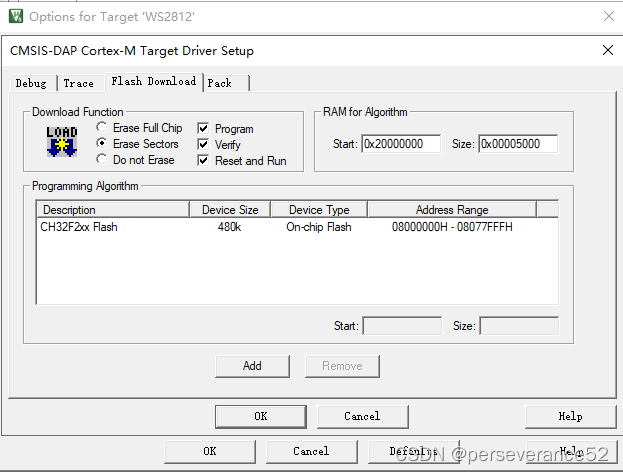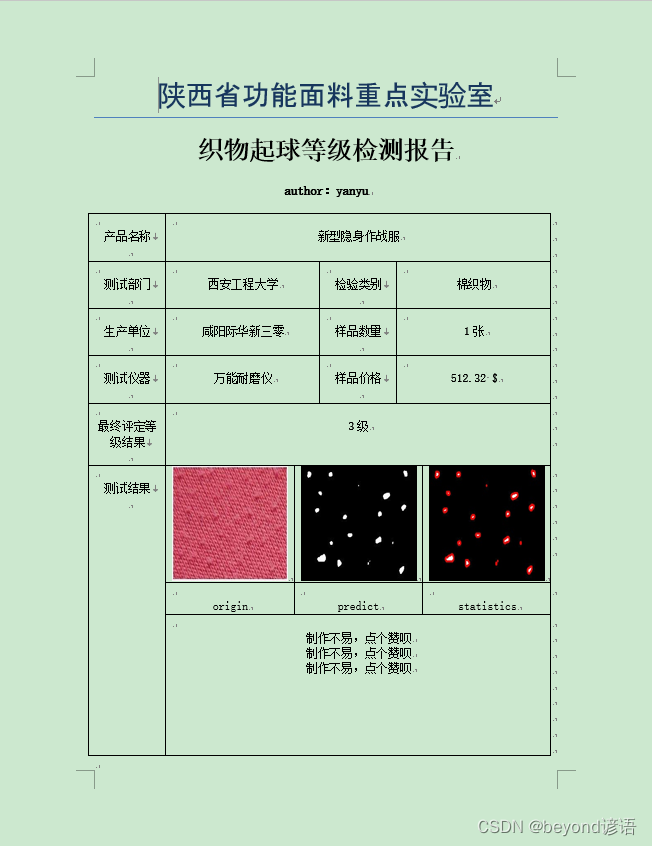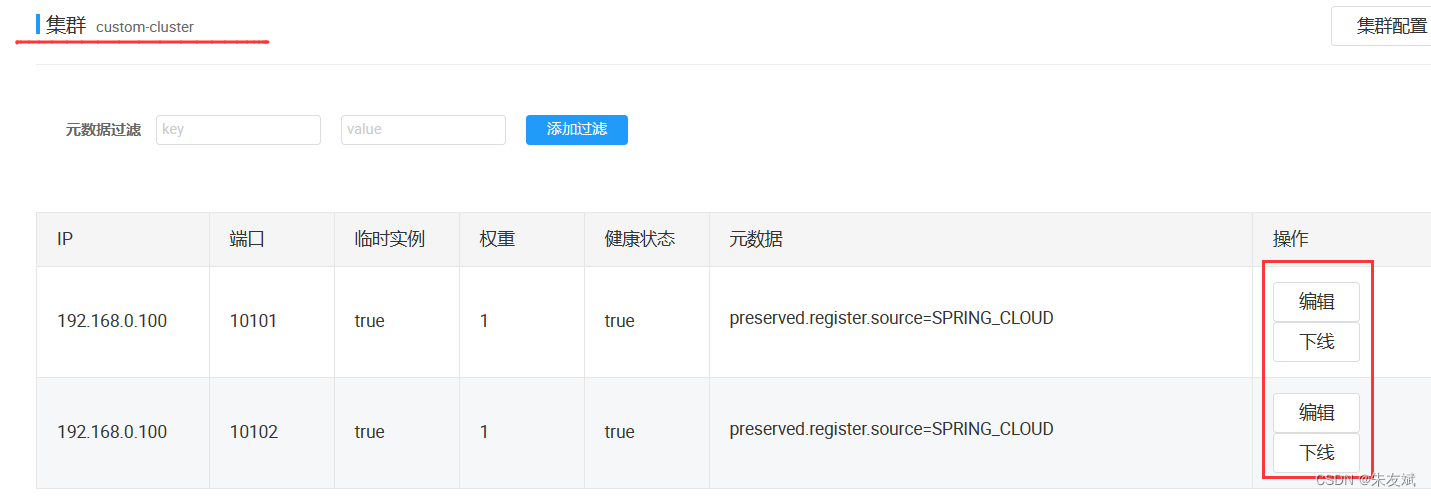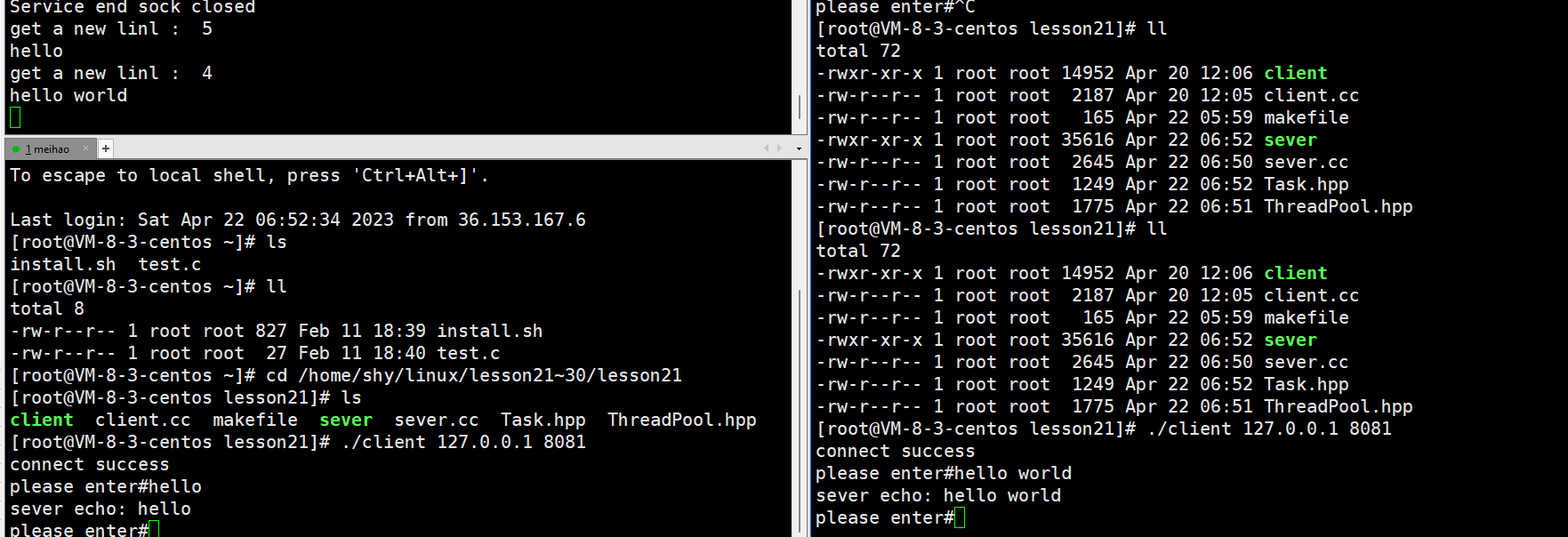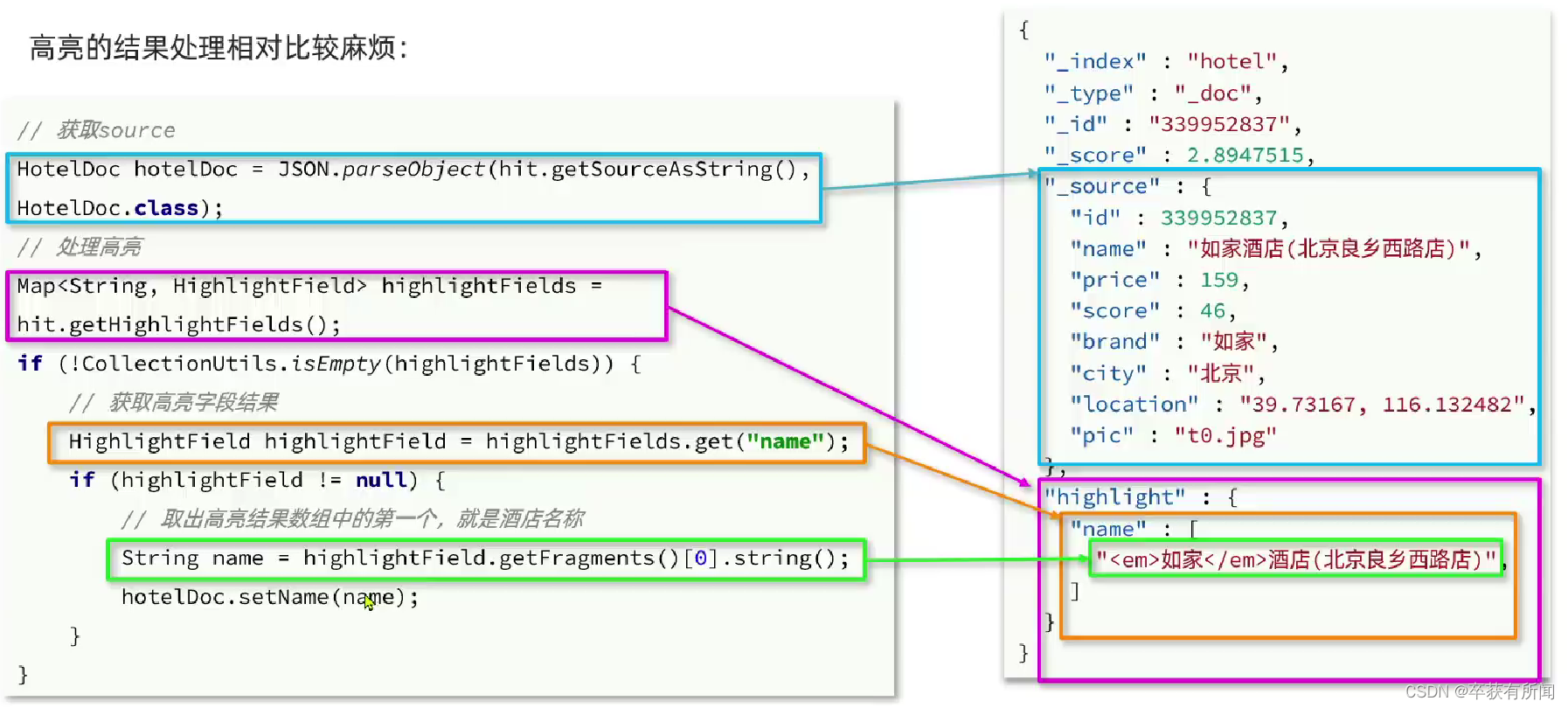Delphi 基础Web Service Application 见:
Delphi Web Server 流程分析_看那山瞧那水的博客-CSDN博客
DataSnap的见:
Delphi DataSnap 流程分析(一)_看那山瞧那水的博客-CSDN博客
Delphi DataSnap 流程分析(二)_看那山瞧那水的博客-CSDN博客
DelphiMVCFrameWork 是个开源的框架,Star 已经1.1K+了,在Pascal里算比较高了。
https://github.com/danieleteti/delphimvcframework
DelphiMVCFrameWork框架的网络通信也是基于Delphi WebBroker技术(早期版本是基于IOComp),使用REST架构。正如框架名称,采用服务端的MVC架构,具体是采用了路由器(Router),控制器(Controler),中间件(Middleware)等结构,这样松耦合的结构,更有利于项目的开发和构建,也更有利用项目的扩展和维护。同时,也可以采用同个作者开源的ORM框架,MVCActivedWork,这样可以更简便开发Database运用。
DelphiMVCFrameWork框架如何挂钩Delphi的WebService?
“Delphi Web Server 流程分析”里,当调用TCustomWebDispatcher.DispatchAction(),
提到:
" Result := DoBeforeDispatch(Request, Response) or Response.Sent;
注意这一行代码!!!这里可以让我们有机会插入请求处理过程及结果。嗯,我们可以在这里"截胡"。"
function TCustomWebDispatcher.DoBeforeDispatch(Request: TWebRequest; Response: TWebResponse): Boolean;
begin
Result := False;
if Assigned(FBeforeDispatch) then
FBeforeDispatch(Self, Request, Response, Result);
end;
DoBeforeDispatch()方法就是执行TWebModule的OnBeforeDispatch事件。
DelphiMVCFrameWork框架就是通过OnBeforeDispatch事件开始"截胡"。这是通过框架的基础核心类TMVCEngine来实现的:
constructor TMVCEngine.Create(const AWebModule: TWebModule; const AConfigAction: TProc<TMVCConfig>;
const ACustomLogger: ILogWriter);
begin
inherited Create(AWebModule);
FWebModule := AWebModule;
FixUpWebModule;
FConfig := TMVCConfig.Create;
FSerializers := TDictionary<string, IMVCSerializer>.Create;
FMiddlewares := TList<IMVCMiddleware>.Create;
FControllers := TObjectList<TMVCControllerDelegate>.Create(True);
FApplicationSession := nil;
FSavedOnBeforeDispatch := nil;
WebRequestHandler.CacheConnections := True;
WebRequestHandler.MaxConnections := 4096;
MVCFramework.Logger.SetDefaultLogger(ACustomLogger);
ConfigDefaultValues;
if Assigned(AConfigAction) then
begin
LogEnterMethod('Custom configuration method');
AConfigAction(FConfig);
LogExitMethod('Custom configuration method');
end;
FConfig.Freeze;
SaveCacheConfigValues;
RegisterDefaultsSerializers;
LoadSystemControllers;
end;
procedure TMVCEngine.FixUpWebModule;
begin
FSavedOnBeforeDispatch := FWebModule.BeforeDispatch;
FWebModule.BeforeDispatch := OnBeforeDispatch;
end;
TMVCEngine创建的时候传入TWebModule实例,然后挂钩OnBeforeDispatch事件,FSavedOnBeforeDispatch 先保存已有的事件,先处理TMVCEngine,处理完后再恢复执行(如果有)。
procedure TMVCEngine.OnBeforeDispatch(ASender: TObject; ARequest: TWebRequest;
AResponse: TWebResponse; var AHandled: Boolean);
begin
AHandled := False;
{ there is a bug in WebBroker Linux on 10.2.1 tokyo }
// if Assigned(FSavedOnBeforeDispatch) then
// begin
// FSavedOnBeforeDispatch(ASender, ARequest, AResponse, AHandled);
// end;
if IsShuttingDown then
begin
AResponse.StatusCode := http_status.ServiceUnavailable;
AResponse.ContentType := TMVCMediaType.TEXT_PLAIN;
AResponse.Content := 'Server is shutting down';
AHandled := True;
end;
if not AHandled then
begin
try
AHandled := ExecuteAction(ASender, ARequest, AResponse);
if not AHandled then
begin
AResponse.ContentStream := nil;
end;
except
on E: Exception do
begin
Log.ErrorFmt('[%s] %s', [E.Classname, E.Message], LOGGERPRO_TAG);
AResponse.StatusCode := http_status.InternalServerError; // default is Internal Server Error
if E is EMVCException then
begin
AResponse.StatusCode := (E as EMVCException).HTTPErrorCode;
end;
AResponse.Content := E.Message;
AResponse.SendResponse;
AHandled := True;
end;
end;
end;
end;
IsShuttingDown使用同步锁实现判断Server是否下线:
function IsShuttingDown: Boolean;
begin
Result := TInterlocked.Read(gIsShuttingDown) = 1
end;
先插入2张图,说明Router、Controler、Middleware的动作系列:
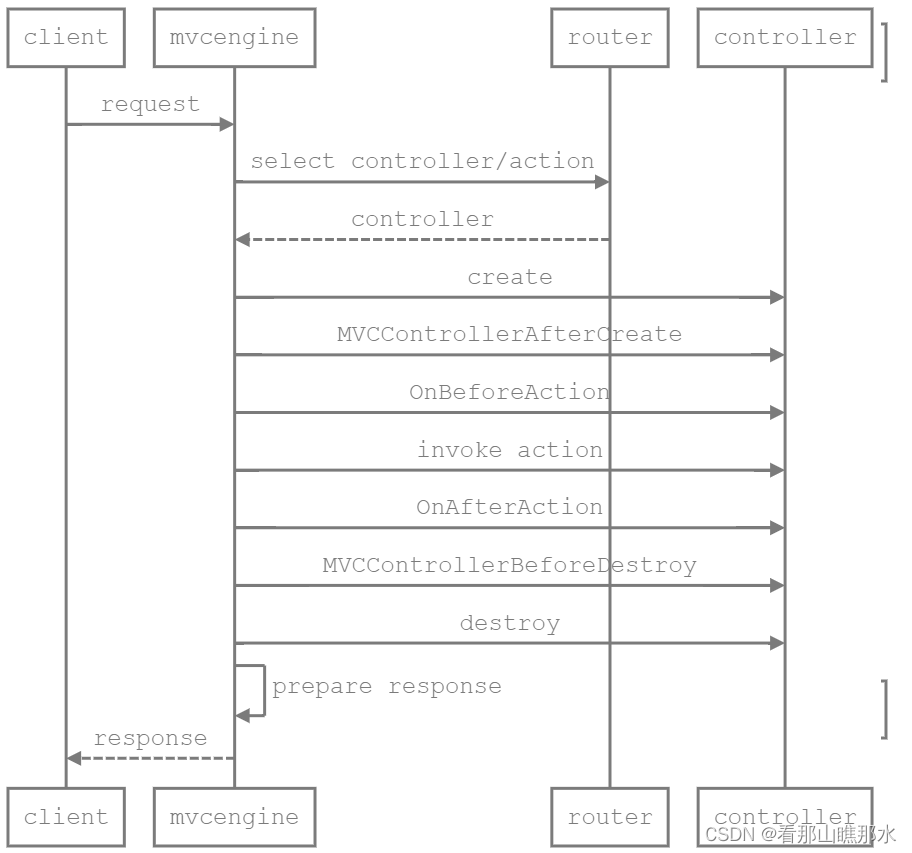
MVCEngine,Router,Controler系列图
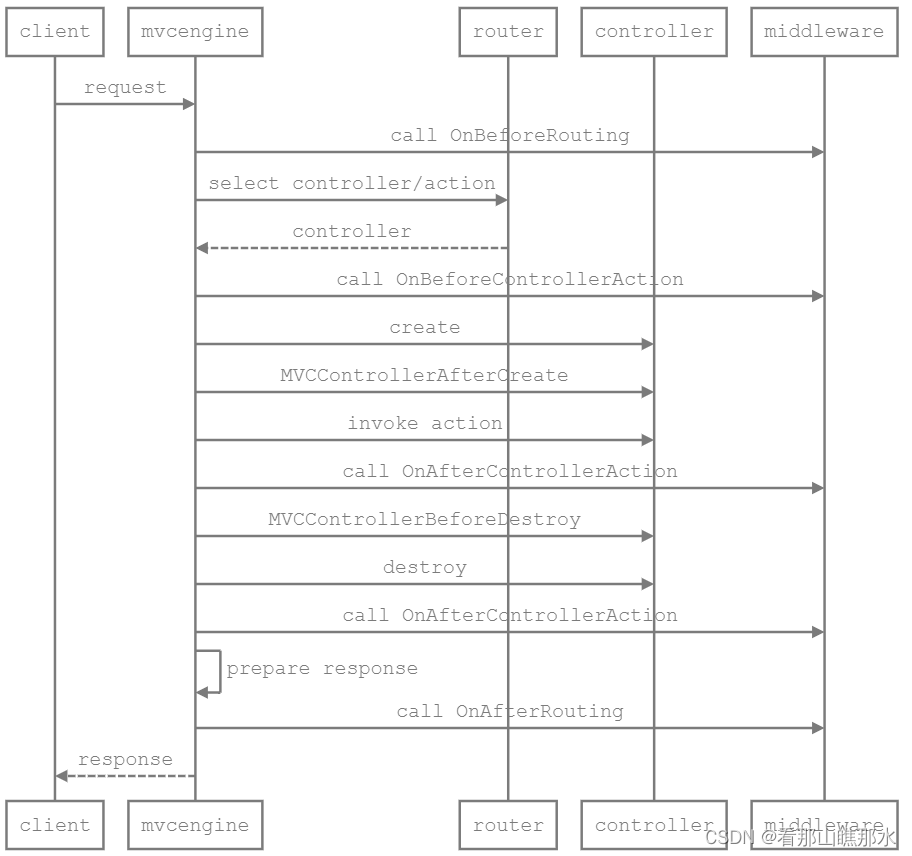
MVCEngine,Router,Controler,MiddleWare系列图
回头看代码,TMVCEngine.ExecuteAction():
function TMVCEngine.ExecuteAction(const ASender: TObject; const ARequest: TWebRequest;
const AResponse: TWebResponse): Boolean;
var
lParamsTable: TMVCRequestParamsTable;
lContext: TWebContext;
lRouter: TMVCRouter;
lHandled: Boolean;
lResponseContentMediaType: string;
lResponseContentCharset: string;
lRouterMethodToCallName: string;
lRouterControllerClazzQualifiedClassName: string;
lSelectedController: TMVCController;
lActionFormalParams: TArray<TRttiParameter>;
lActualParams: TArray<TValue>;
lBodyParameter: TObject;
begin
Result := False;
if ARequest.ContentLength > FConfigCache_MaxRequestSize then
begin
raise EMVCException.CreateFmt(http_status.RequestEntityTooLarge,
'Request size exceeded the max allowed size [%d KiB] (1)',
[(FConfigCache_MaxRequestSize div 1024)]);
end;
{$IF Defined(BERLINORBETTER)}
ARequest.ReadTotalContent;
// Double check for malicious content-length header
if ARequest.ContentLength > FConfigCache_MaxRequestSize then
begin
raise EMVCException.CreateFmt(http_status.RequestEntityTooLarge,
'Request size exceeded the max allowed size [%d KiB] (2)',
[(FConfigCache_MaxRequestSize div 1024)]);
end;
{$ENDIF}
lParamsTable := TMVCRequestParamsTable.Create;
try
lContext := TWebContext.Create(ARequest, AResponse, FConfig, FSerializers);
try
DefineDefaultResponseHeaders(lContext);
DoWebContextCreateEvent(lContext);
lHandled := False;
lRouter := TMVCRouter.Create(FConfig, gMVCGlobalActionParamsCache);
try // finally
lSelectedController := nil;
try // only for lSelectedController
try // global exception handler
ExecuteBeforeRoutingMiddleware(lContext, lHandled);
if not lHandled then
begin
if lRouter.ExecuteRouting(ARequest.PathInfo,
lContext.Request.GetOverwrittenHTTPMethod { lContext.Request.HTTPMethod } ,
ARequest.ContentType, ARequest.Accept, FControllers,
FConfigCache_DefaultContentType, FConfigCache_DefaultContentCharset,
FConfigCache_PathPrefix, lParamsTable, lResponseContentMediaType,
lResponseContentCharset) then
begin
try
if Assigned(lRouter.ControllerCreateAction) then
lSelectedController := lRouter.ControllerCreateAction()
else
lSelectedController := lRouter.ControllerClazz.Create;
except
on Ex: Exception do
begin
Log.ErrorFmt('[%s] %s [PathInfo "%s"] (Custom message: "%s")',
[Ex.Classname, Ex.Message, GetRequestShortDescription(ARequest), 'Cannot create controller'], LOGGERPRO_TAG);
raise EMVCException.Create(http_status.InternalServerError,
'Cannot create controller');
end;
end;
lRouterMethodToCallName := lRouter.MethodToCall.Name;
lRouterControllerClazzQualifiedClassName := lRouter.ControllerClazz.QualifiedClassName;
MVCFramework.Logger.InitThreadVars;
lContext.fActionQualifiedName := lRouterControllerClazzQualifiedClassName + '.'+ lRouterMethodToCallName;
lSelectedController.Engine := Self;
lSelectedController.Context := lContext;
lSelectedController.ApplicationSession := FApplicationSession;
lContext.ParamsTable := lParamsTable;
ExecuteBeforeControllerActionMiddleware(
lContext,
lRouterControllerClazzQualifiedClassName,
lRouterMethodToCallName,
lHandled);
if lHandled then
Exit(True);
lBodyParameter := nil;
lSelectedController.MVCControllerAfterCreate;
try
lHandled := False;
lSelectedController.ContentType := BuildContentType(lResponseContentMediaType,
lResponseContentCharset);
lActionFormalParams := lRouter.MethodToCall.GetParameters;
if (Length(lActionFormalParams) = 0) then
SetLength(lActualParams, 0)
else if (Length(lActionFormalParams) = 1) and
(SameText(lActionFormalParams[0].ParamType.QualifiedName,
'MVCFramework.TWebContext')) then
begin
SetLength(lActualParams, 1);
lActualParams[0] := lContext;
end
else
begin
FillActualParamsForAction(lSelectedController, lContext, lActionFormalParams,
lRouterMethodToCallName, lActualParams, lBodyParameter);
end;
lSelectedController.OnBeforeAction(lContext, lRouterMethodToCallName, lHandled);
if not lHandled then
begin
try
lRouter.MethodToCall.Invoke(lSelectedController, lActualParams);
finally
lSelectedController.OnAfterAction(lContext, lRouterMethodToCallName);
end;
end;
finally
try
lBodyParameter.Free;
except
on E: Exception do
begin
LogE(Format('Cannot free Body object: [CLS: %s][MSG: %s]',
[E.Classname, E.Message]));
end;
end;
lSelectedController.MVCControllerBeforeDestroy;
end;
ExecuteAfterControllerActionMiddleware(lContext,
lRouterControllerClazzQualifiedClassName,
lRouterMethodToCallName,
lHandled);
lContext.Response.ContentType := lSelectedController.ContentType;
fOnRouterLog(lRouter, rlsRouteFound, lContext);
end
else // execute-routing
begin
if Config[TMVCConfigKey.AllowUnhandledAction] = 'false' then
begin
lContext.Response.StatusCode := http_status.NotFound;
lContext.Response.ReasonString := 'Not Found';
fOnRouterLog(lRouter, rlsRouteNotFound, lContext);
raise EMVCException.Create(lContext.Response.ReasonString,
lContext.Request.HTTPMethodAsString + ' ' + lContext.Request.PathInfo, 0,
http_status.NotFound);
end
else
begin
lContext.Response.FlushOnDestroy := False;
end;
end; // end-execute-routing
end; // if not handled by beforerouting
except
on ESess: EMVCSessionExpiredException do
begin
if not CustomExceptionHandling(ESess, lSelectedController, lContext) then
begin
Log.ErrorFmt('[%s] %s [PathInfo "%s"] (Custom message: "%s")',
[ESess.Classname, ESess.Message, GetRequestShortDescription(ARequest),
ESess.DetailedMessage], LOGGERPRO_TAG);
lContext.SessionStop;
lSelectedController.ResponseStatus(ESess.HTTPErrorCode);
lSelectedController.Render(ESess);
end;
end;
on E: EMVCException do
begin
if not CustomExceptionHandling(E, lSelectedController, lContext) then
begin
Log.ErrorFmt('[%s] %s [PathInfo "%s"] (Custom message: "%s")',
[E.Classname, E.Message, GetRequestShortDescription(ARequest), E.DetailedMessage], LOGGERPRO_TAG);
if Assigned(lSelectedController) then
begin
lSelectedController.ResponseStatus(E.HTTPErrorCode);
lSelectedController.Render(E);
end
else
begin
SendRawHTTPStatus(lContext, E.HTTPErrorCode,
Format('[%s] %s', [E.Classname, E.Message]), E.Classname);
end;
end;
end;
on EIO: EInvalidOp do
begin
if not CustomExceptionHandling(EIO, lSelectedController, lContext) then
begin
Log.ErrorFmt('[%s] %s [PathInfo "%s"] (Custom message: "%s")',
[EIO.Classname, EIO.Message, GetRequestShortDescription(ARequest), 'Invalid Op'], LOGGERPRO_TAG);
if Assigned(lSelectedController) then
begin
lSelectedController.ResponseStatus(http_status.InternalServerError);
lSelectedController.Render(EIO);
end
else
begin
SendRawHTTPStatus(lContext, http_status.InternalServerError,
Format('[%s] %s', [EIO.Classname, EIO.Message]), EIO.Classname);
end;
end;
end;
on Ex: Exception do
begin
if not CustomExceptionHandling(Ex, lSelectedController, lContext) then
begin
Log.ErrorFmt('[%s] %s [PathInfo "%s"] (Custom message: "%s")',
[Ex.Classname, Ex.Message, GetRequestShortDescription(ARequest), 'Global Action Exception Handler'], LOGGERPRO_TAG);
if Assigned(lSelectedController) then
begin
lSelectedController.ResponseStatus(http_status.InternalServerError);
lSelectedController.Render(Ex);
end
else
begin
SendRawHTTPStatus(lContext, http_status.InternalServerError,
Format('[%s] %s', [Ex.Classname, Ex.Message]), Ex.Classname);
end;
end;
end;
end;
try
ExecuteAfterRoutingMiddleware(lContext, lHandled);
except
on Ex: Exception do
begin
if not CustomExceptionHandling(Ex, lSelectedController, lContext) then
begin
Log.ErrorFmt('[%s] %s [PathInfo "%s"] (Custom message: "%s")',
[Ex.Classname, Ex.Message, GetRequestShortDescription(ARequest), 'After Routing Exception Handler'], LOGGERPRO_TAG);
if Assigned(lSelectedController) then
begin
{ middlewares *must* not raise unhandled exceptions }
lSelectedController.ResponseStatus(http_status.InternalServerError);
lSelectedController.Render(Ex);
end
else
begin
SendRawHTTPStatus(lContext, http_status.InternalServerError,
Format('[%s] %s', [Ex.Classname, Ex.Message]), Ex.Classname);
end;
end;
end;
end;
finally
FreeAndNil(lSelectedController);
end;
finally
lRouter.Free;
end;
finally
DoWebContextDestroyEvent(lContext);
lContext.Free;
end;
finally
lParamsTable.Free;
end;
end;
首先判断请求内容的长度是否超长,FConfigCache_MaxRequestSize是配置常量,默认5MB(5*1024*1024, MVCFramework.Commons.pas 单元的 TMVCConstants结构),
lParamsTable: TMVCRequestParamsTable,只是TDictionary<string,string>别名。
MVCFrameWork框架有自己的一套 Context,Request,Response,均定义在MVCFramework.pas单元,TMVCWebRequest包装了系统的TWebRequest,TMVCWebResponse包装了系统的TWebResponse,TWebContext是重新定义的。
DefineDefaultResponseHeaders()定制默认的Header。
lRouter := TMVCRouter.Create(FConfig, gMVCGlobalActionParamsCache);
创建路由器,FConfig是Web配置,gMVCGlobalActionParamsCache参数是个全局线程安全对象,用于缓存动作参数列表。
ExecuteBeforeRoutingMiddleware(lContext, lHandled);
执行中间件的OnBeforeRouting(),然后开始执行路由lRouter.ExecuteRouting():
function TMVCRouter.ExecuteRouting(const ARequestPathInfo: string;
const ARequestMethodType: TMVCHTTPMethodType;
const ARequestContentType, ARequestAccept: string;
const AControllers: TObjectList<TMVCControllerDelegate>;
const ADefaultContentType: string;
const ADefaultContentCharset: string;
const APathPrefix: string;
var ARequestParams: TMVCRequestParamsTable;
out AResponseContentMediaType: string;
out AResponseContentCharset: string): Boolean;
var
LRequestPathInfo: string;
LRequestAccept: string;
LRequestContentType: string;
LControllerMappedPath: string;
LControllerMappedPaths: TStringList;
LControllerDelegate: TMVCControllerDelegate;
LAttributes: TArray<TCustomAttribute>;
LAtt: TCustomAttribute;
LRttiType: TRttiType;
LMethods: TArray<TRttiMethod>;
LMethod: TRttiMethod;
LMethodPath: string;
LProduceAttribute: MVCProducesAttribute;
lURLSegment: string;
LItem: String;
// JUST FOR DEBUG
// lMethodCompatible: Boolean;
// lContentTypeCompatible: Boolean;
// lAcceptCompatible: Boolean;
begin
Result := False;
FMethodToCall := nil;
FControllerClazz := nil;
FControllerCreateAction := nil;
LRequestAccept := ARequestAccept;
LRequestContentType := ARequestContentType;
LRequestPathInfo := ARequestPathInfo;
if (Trim(LRequestPathInfo) = EmptyStr) then
LRequestPathInfo := '/'
else
begin
if not LRequestPathInfo.StartsWith('/') then
begin
LRequestPathInfo := '/' + LRequestPathInfo;
end;
end;
//LRequestPathInfo := TNetEncoding.URL.EncodePath(LRequestPathInfo, [Ord('$')]);
LRequestPathInfo := TIdURI.PathEncode(Trim(LRequestPathInfo)); //regression introduced in fix for issue 492
TMonitor.Enter(gLock);
try
//LControllerMappedPaths := TArray<string>.Create();
LControllerMappedPaths := TStringList.Create;
try
for LControllerDelegate in AControllers do
begin
LControllerMappedPaths.Clear;
SetLength(LAttributes, 0);
LRttiType := FRttiContext.GetType(LControllerDelegate.Clazz.ClassInfo);
lURLSegment := LControllerDelegate.URLSegment;
if lURLSegment.IsEmpty then
begin
LAttributes := LRttiType.GetAttributes;
if (LAttributes = nil) then
Continue;
//LControllerMappedPaths := GetControllerMappedPath(LRttiType.Name, LAttributes);
FillControllerMappedPaths(LRttiType.Name, LAttributes, LControllerMappedPaths);
end
else
begin
LControllerMappedPaths.Add(lURLSegment);
end;
for LItem in LControllerMappedPaths do
begin
LControllerMappedPath := LItem;
if (LControllerMappedPath = '/') then
begin
LControllerMappedPath := '';
end;
{$IF defined(TOKYOORBETTER)}
if not LRequestPathInfo.StartsWith(APathPrefix + LControllerMappedPath, True) then
{$ELSE}
if not TMVCStringHelper.StartsWith(APathPrefix + LControllerMappedPath, LRequestPathInfo, True) then
{$ENDIF}
begin
Continue;
end;
// end;
// if (not LControllerMappedPathFound) then
// continue;
LMethods := LRttiType.GetMethods; { do not use GetDeclaredMethods because JSON-RPC rely on this!! }
for LMethod in LMethods do
begin
if LMethod.Visibility <> mvPublic then // 2020-08-08
Continue;
if (LMethod.MethodKind <> mkProcedure) { or LMethod.IsClassMethod } then
Continue;
LAttributes := LMethod.GetAttributes;
if Length(LAttributes) = 0 then
Continue;
for LAtt in LAttributes do
begin
if LAtt is MVCPathAttribute then
begin
// THIS BLOCK IS HERE JUST FOR DEBUG
// if LMethod.Name.Contains('GetProject') then
// begin
// lMethodCompatible := True; //debug here
// end;
// lMethodCompatible := IsHTTPMethodCompatible(ARequestMethodType, LAttributes);
// lContentTypeCompatible := IsHTTPContentTypeCompatible(ARequestMethodType, LRequestContentType, LAttributes);
// lAcceptCompatible := IsHTTPAcceptCompatible(ARequestMethodType, LRequestAccept, LAttributes);
if IsHTTPMethodCompatible(ARequestMethodType, LAttributes) and
IsHTTPContentTypeCompatible(ARequestMethodType, LRequestContentType, LAttributes) and
IsHTTPAcceptCompatible(ARequestMethodType, LRequestAccept, LAttributes) then
begin
LMethodPath := MVCPathAttribute(LAtt).Path;
if IsCompatiblePath(APathPrefix + LControllerMappedPath + LMethodPath,
LRequestPathInfo, ARequestParams) then
begin
FMethodToCall := LMethod;
FControllerClazz := LControllerDelegate.Clazz;
FControllerCreateAction := LControllerDelegate.CreateAction;
LProduceAttribute := GetAttribute<MVCProducesAttribute>(LAttributes);
if LProduceAttribute <> nil then
begin
AResponseContentMediaType := LProduceAttribute.Value;
AResponseContentCharset := LProduceAttribute.Charset;
end
else
begin
AResponseContentMediaType := ADefaultContentType;
AResponseContentCharset := ADefaultContentCharset;
end;
Exit(True);
end;
end;
end; // if MVCPathAttribute
end; // for in Attributes
end; // for in Methods
end;
end; // for in Controllers
finally
LControllerMappedPaths.Free;
end;
finally
TMonitor.Exit(gLock);
end;
end;
对URL路由,URL参数等进行解析,找到当前执行的Controler及要执行的方法(Action)及参数等,
执行方法并返回客户端。
将结果返回客户端,有个专门的通用方法Render(),
TMVCRenderer = class(TMVCBase)
TMVCController = class(TMVCRenderer)
TMVCRenderer类里定义了各种各样的Render()方法,TMVCController是TMVCRenderer的子类,可以方便调用。
看几个Render()方法定义:
procedure Render(const AContent: string); overload;
procedure Render(const AStatusCode: Integer; const AContent: string); overload;
procedure Render(const AStatusCode: Integer); overload;
.......................
procedure Render(const AObject: TObject;
const ASerializationAction: TMVCSerializationAction = nil;
const AIgnoredFields: TMVCIgnoredList = nil); overload;
procedure Render(const AObject: TObject; const AOwns: Boolean;
const ASerializationAction: TMVCSerializationAction = nil;
const AIgnoredFields: TMVCIgnoredList = nil); overload;
...............
这样的Render()方法有差不多30个...............
这里只是粗略介绍了DelphiMVCFrameWork框架,没有深入进去,后续再详细分析,比如认证授权、ORM等部分。



